Introduction
Harking back to our romanticized notions of the veritable Spanish Armada and the early transatlantic trade routes of the 16th century, the Galleon serves as the quintessential template of the Spanish naval might. These multi-decked ships, with their three masts and fore-and-aft rig, were designed as warships with both cargo and troop-carrying capacity.
And while their Mediterranean origins are undeniable, galleons were also developed by northern European powers of the time, thereby signifying the effectiveness of the vessel design and its armed capability. So without further ado, let us take a gander at the fascinating history and evolution of the galleon – the exemplary warship of the 16th-17th century.
Contents
- Introduction
- The Development of the Galleon
- The First Galleons of the 16th Century
- The Royal Galleon of the Spanish Fleet
- The Shipbuilding of Spanish Galleons
- The Sails of the Spanish Galeón
- The Influence of Castles
- The Armament of Galleons
- The Flota and Purpose of the Galleon
- The Crew Capacity of Galleons
- The Life Onboard the Galleon
- The Evolution of the Galleon into a True Warship
- Conclusion – The Decline
- Honorable Mention – The Golden Hind
The Development of the Galleon
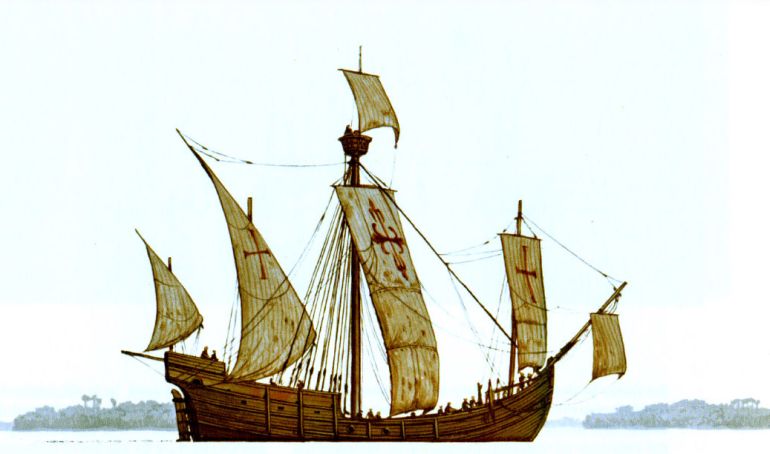
According to historian Angus Konstam, the early 16th century was a period of innovation for ship designs, with the adoption of better sailing rigs and onboard artillery systems. By this time, the caravel was the highly-maneuverable sailing ship used for exploration, while larger carrack (or the Mediterranean equivalent – the nao, with slightly different features), based on the design of cogs, appeared as the dominant warship and merchant’s vessel for many a European navy.
To that end, one hypothesis put forth in academic circles relates to how the galleon was based on the design of caravels, possibly because of its ‘sleeker’ form factor. However, the galleon also shared some design features with the nao, given its sturdier construction and stronger sailing rig.
In essence, it can be surmised that the galleon design was inspired by the combination of both the maneuverability of caravels and the hefty nature of carracks, bolstered by the millennia-old tradition of shipbuilding along the Mediterranean coast. In that regard, during the Battle of Preveza, circa 1538 AD, a Venetian ship, described as a galleon, was said to have countered multiple Turkish galleys – thereby suggesting how the vessel was well-armed and yet maneuverable.
Simply put, while the earlier carracks and naos were used as ‘multirole’ cumbersome warships and merchant vessels, the galleon was possibly developed as a specialized large sailing ship with a keel-up design dedicated primarily to naval battles and encounters (but modified over time with cargo-carrying capacity – discussed later in the article).
The First Galleons of the 16th Century
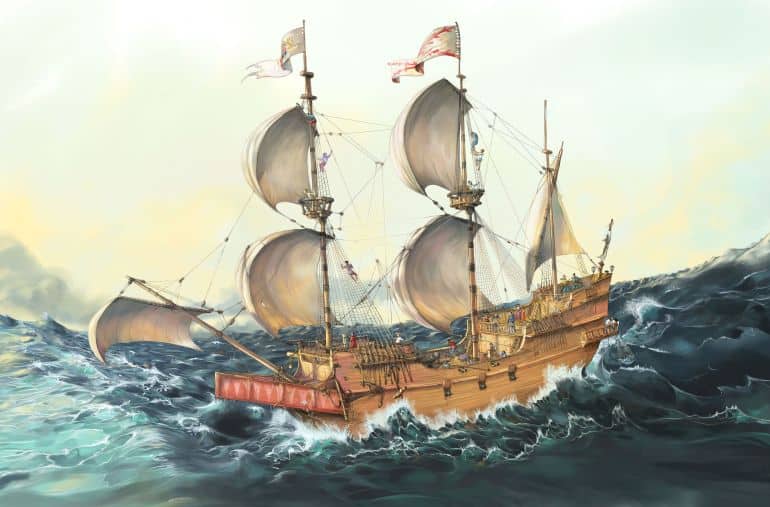
In the 1520s, the Portuguese used patrol vessels in the Indian Ocean known as galleones, while by the 1530s, the French referred to the Spanish warships as galeons. Interestingly enough, the Spaniards themselves used the term galeón (meaning – ‘armed merchant ship’) for one of their vessels that was designed to fight the Barbary pirates in 1517 AD.
By the 1540s, the Spanish galeón was built as a dedicated warship (with some cargo-carrying capacity) that was typically smaller than naos. These well-armed vessels relied on sails while being also accommodated with secondary oars (or sweeps) until the latter mechanism was totally relegated by the 1560s.
During the time of King Philip II’s reign (1556-98), the Spanish galleon increased in size and capacity. For example, while the earlier galleons had capacities for 120 toneladas (Spanish tons), the post-1560 galleons tended to cross thresholds of 330 toneladas.
These ships were also progressively used as escort vessels (in place of the ponderous naos) for the naval convoys that traveled between Spain and the Americas. This trend of adopting larger sizes for Atlantic convoys explains the (later) removal of oar-based systems from the vessels since sweeps mostly came in handy in coastal areas and calm seas, not the high seas.
It should also be noted that the Spanish may have used the term galleon (or galeón) for most types of warships in their navy, while the Portuguese possibly used it to denote a particular type of warship. Quite intriguingly, even the English designed their own version of a galleon (or a vessel that was somewhat visually akin to a galleon) in 1545 AD known as the gallyon, but the craft was smaller in size with sweeps.
The Royal Galleon of the Spanish Fleet
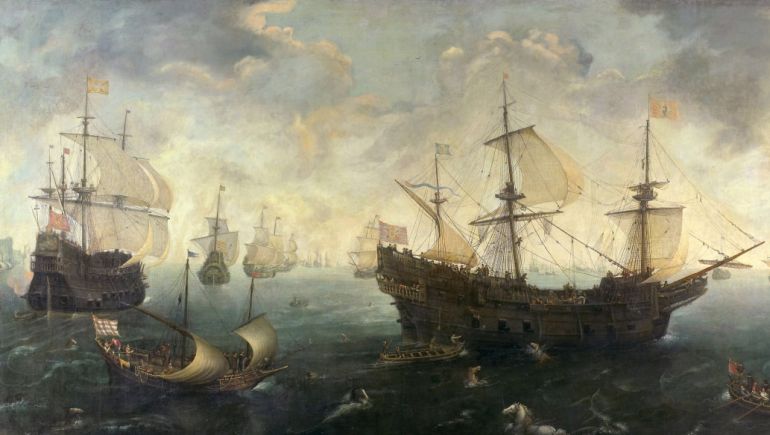
By the 1570s, the size of the Spanish galleon was increased even further to average capacities of around 500 tons. And by 1588 AD, when the Spanish Armada arguably was at its peak, the crown boasted three humongous 1,000-ton galleons accompanied by eight 800-ton galleons and eight 600-ton galleons. Such massive sizes were complemented by graceful designs, with a sharper stern, sleeker length-to-beam ratio (when compared to bulkier carracks), and a more effective hull shape for carrying artillery.
However, this seemingly ambitious phase of shipbuilding was only transitory – since the Spanish crown decided to ‘refocus’ on the commercial potential of the galleon. Furthermore, the very same period might have corresponded to a crisis in the shipbuilding sector, especially in northern Spain.
Also, the 1588 campaign was a shock defeat for the Spanish Armada, and the result may have ushered in changes in the Spanish navy. Believed to be the largest engagement of the undeclared Anglo-Spanish War (1585-1604), the bulky Spanish Galeóns were decisively defeated by the combination of English fireships and Dutch flyboats.
So by the 1590s, till the mid-1600s, the galleons tended to be even more trimmed, with their capacities averaging around 500 toneladas. King Philip III (who reigned from 1598-1621 AD) aimed to directly control the coin (specie) shipments from the Americas to Spain by stipulating how the cargo should only be transported via his royal galleons.
Essentially, this translated to the Spanish crown’s near-monopoly on the transatlantic trade route that covered not only coins and ingots of silver and gold but also a wealth of other valuable items like emeralds and pearls.
Consequently, many of these treasure-carrying Royal Galleons were designed to be smaller and less armed than their continental cousins. The reduction in their war capability possibly also reflects how the Spaniards faced little to no opposition on their maritime trade routes, especially during the period between the 1590s till 1620s.
During the same period (by 1565), the Spanish navy also employed what has been termed the Manila Galleon (Galeón de Manila). Reflecting the name of the town they set sail from, these Manila Galleons possibly made two round trips in a year – all the way from Manila (in the Philippines) to Acapulco (in Mexico). Operating for 250 years, the massive cargo ships sailed and carried forth luxury items like spices and porcelain to the ‘New World‘ in exchange for silver.
The Shipbuilding of Spanish Galleons
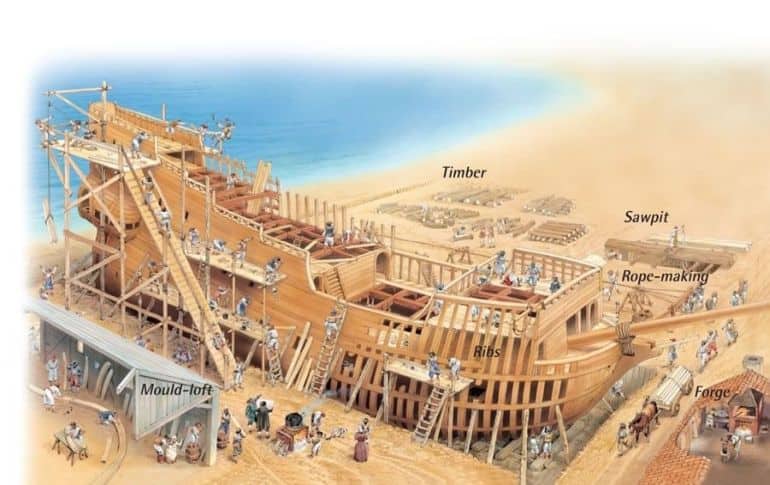
The very scope of shipbuilding in Europe witnessed a shift in paradigm after the 1580s. Whereas earlier patterns entailed the experienced (but still personal) judgment of the generational shipbuilders, the late 16th and early 17th centuries brought forth the ideals of mathematical precision and measurements that dictated the flow of work and design elements of maritime vessels. In essence, sea crafts were built for specific purposes and their individual designs and schemas reflected such a function-based direction.
Coming to the shipbuilding of Spanish galleons, like other European nations, Spain also made practical changes to the operational ambit of the industry. In that regard, the earlier galleons and other warships were the products of ill-conceived ‘agreements’ that forced shipbuilders to work within the confines of royal shipyards.
But by the early 17th century, the crown offered incentives to private contractors and financiers to build their warships from the ground up. Such arrangements were complemented by strict regulations that dictated the specified construction and adjustment of almost every section of the ship.
The primary shipyards in the 16th-century Spanish Empire pertained to the Basque coast of northern Spain and the southern Andalusian coast, while (oddly enough) the eastern Mediterranean coastline was largely left out of the galleon-building industry. By the latter part of the century, the empire could also call upon Portuguese shipyards and foreign ports in Italy, Sicily, and Flanders to provide resources for their shipbuilding endeavors.
By the 17th century, Havana became the center of galleon-building in the Caribbean due to its proximity to high-quality Cuban timber. And in mainland Spain, Bilbao and its surrounding regions became the most important center for shipbuilding, not only because of access to good-quality timber but also because the nearby Basque area iron industries furnished the artillery needed for the galleons.
Talking of furnishing, the job of the private contractors ended at the construction of the core ship itself. So after the delivery of the galleon, it was the responsibility of the crown to outfit the vessel with various components and armaments, ranging from navigational instruments, ordinance, and ship boats to even the decoration of the craft (usually comprising religiously-inspired figures).
The Sails of the Spanish Galeón
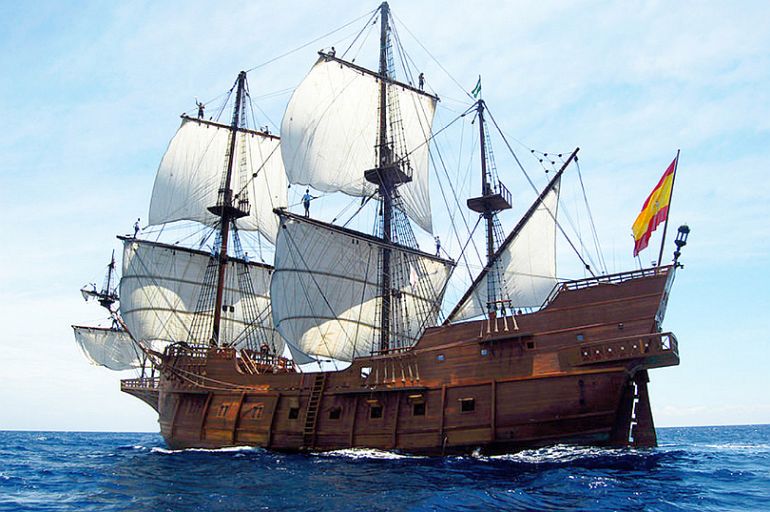
The original galleon began as a dependable war vessel that usually had three or more masts. Now interestingly enough, the ship masts were both square-rigged and lateen-rigged for effective maneuverability on the water.
For example, the lateen sail (triangular sail set), known for its better maneuverability, especially ‘against the wind’, was usually used when the ships were navigating through the Mediterranean into the Atlantic. But once the vessel was on the high ocean, the lateens were replaced by the sturdy square sails suited to stormy weather.
Over time, the ships were furnished with the ‘mixed’ design wherein the foremast and the main mast were square-rigged, while the mizzenmast had lateen sail. The larger galleons even had a fourth mast, with a lateen-rigged mizzen – known as the Bonaventure mizzen.
The Influence of Castles
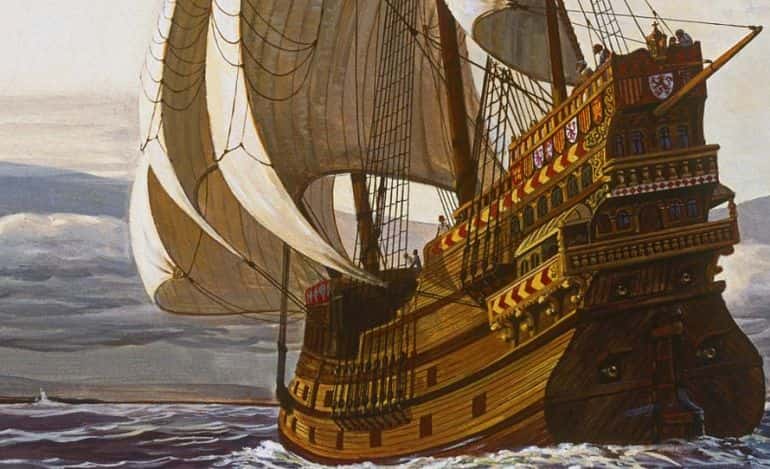
According to historian Angus Konstam, the various sections of the galleon decks were named after castle elements. For example, the multi-tiered sterncastle behind the mainmast (or mizzenmast) was often referred to as the alcazar (fortress), while the entire space was also called the tolda (awning). Similarly, the smaller forecastle (upper deck forward of the foremast) was simply called the castillo (castle).
Now judging by this nomenclature, it becomes somewhat evident that the Spanish viewed their galleon ships as naval extensions of actual fortresses on land. Thus the bulky nature of the sterncastle or alcazar, while sometimes having a detrimental effect on the maneuvering of the ship itself, also symbolized the imposing stature of the galleon.
In essence, the galleons, especially the larger specimens, were perceived as floating fortresses (albeit with finer design considerations when compared to carracks) that could accommodate their fair share of defenders – in the form of well-trained musketeers who could perform boarding actions. Thus in the initial phases of galleon development during the 16th century, the onboard artillery only took a secondary role, while boarding actions were still given preference by the Spanish commanders.
The Armament of Galleons
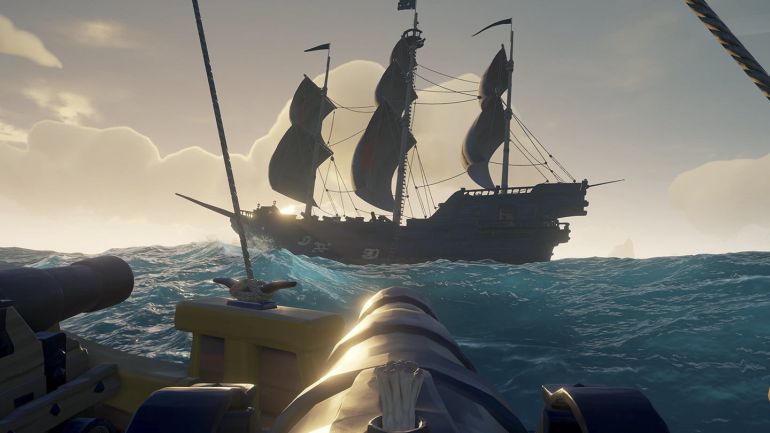
As we mentioned before in the article, the placement and fixing of cannons atop naval crafts were the responsibilities of the Spanish royal authorities, and, this, in turn, resulted in the valid documentation of the types of weapon systems, artillery, and ordnance used by the galleon.
Incredibly enough, the guns, along with the powder and shot, were mostly manufactured by royal foundries and workshops (while in some cases, cannons were also imported from abroad) – and as such, the Spanish relied on an ‘economical’ system where guns were specifically furnished for the galleon-type with allocated ammunition that had to be returned to the royal authorities if left unused.
As for the guns themselves, according to Angus Konstam, there were several varieties, including the larger canones (cannons), culebrinas (culverins), pedreros (stone-shotted guns), bombardettas (wrought-iron guns), and versos (swivel guns).
Among these, the pedreros – used as close-range anti-personnel weapons, and bombardettas – with their lower ranges when compared to bronze guns, were increasingly considered outdated by the 17th century. On the other hand, the versos, with their swivel-mount and faster breech-loading mechanisms, were effective and flexible for both solid-shot and grapeshot.
Suffice it to say, the canones and culebrinas (subdivided into various weights and sizes) were the mainstays of the Spanish galleon, and the capacity of the vessel itself often mirrored the number of guns on board. For example, in the Spanish navy, the 700-850 toneladas galleons carried around 30-40 guns (divided between canones, culebrinas, and other smaller guns), while the largest 1,000-toneladas ones carried 50 guns.
Similarly, the smaller 500-toneladas varieties carried 24 guns, while the even tinier 300-toneladas galleons carried around 20 guns. In terms of placements, the largest guns were carried as stern chasers, while the others, divided between the two broadsides, were arranged along a long gundeck.
The Flota and Purpose of the Galleon
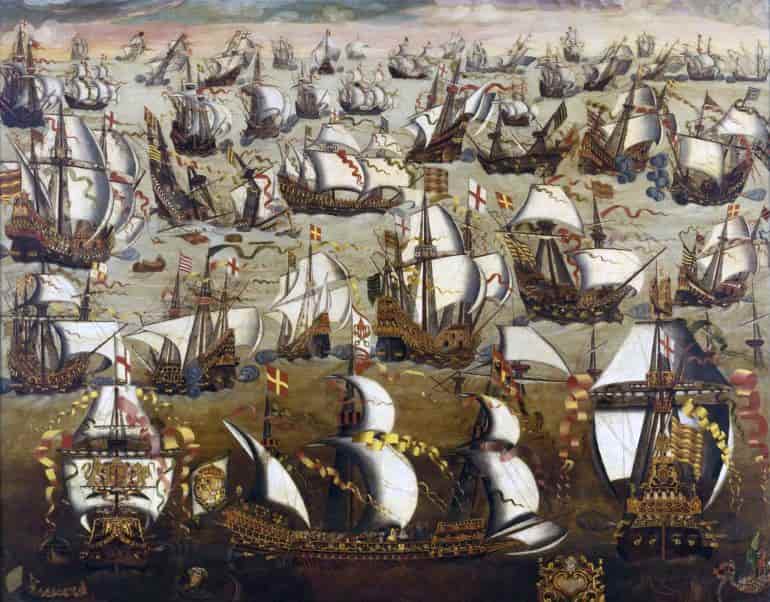
The Spanish Empire’s exploits in the Americas converted to massive economic dividends. Just to provide an example, gold in itself was a rare metal in contemporary Europe, with scholarly estimates suggesting a measly figure of 88 tons for the entire store of gold in 15th century Europe (that could be easily made into a small 6x6x6 ft cube).
By circa 1560 AD, Spain alone accounted for 99 tons of gold shipped from the New World. However, the transatlantic routes also brought forth their fair share of logistical challenges – with the primary one pertaining to how early 16th-century Spanish merchant ships had to operate on their own in those dangerous voyages.
By the 1520s, a solution was hatched in the form of the averia – a special tax levied on goods traded across the Atlantic, and the money, in turn, was used to fund the crafting of warships that were to escort the merchant vessels.
In 1526 AD, the Spanish crown decided upon the flota system which basically entailed convoys of vessels guarded by armed escort ships. And while during the early half of the 16th century, such escorting duties were carried out by naos, the further increase in averia (due to risks of foreign attack on the flotas), along with the advent of more evolved shipbuilding techniques, allowed the galleons to take center stage in such Spanish flotas.
In essence, the first true galleons of the Spanish fleet were possibly built as dedicated escort ships for merchant vessels. These escorting galleons, called the Armada de la Guardia, were part of the Armada del Mar Oceano (Atlantic Fleet) from the 1580s, and the latter organization ultimately morphed into a permanent navy in the 17th century.
To that end, it should be noted that the Spanish navy consisted of different kinds of vessels and warships, ranging from the naos, and galleasses to smaller crafts. By 1588 AD, there were only around 20 galleons among over 120 ships of the Armada – but they formed the offensive ‘spearhead’ of the much-vaunted fleet.
Over time, their versatility also translated into a commercial advantage, with some of the galleons being converted into armed coin-carrying ships of the Spanish crown – as mentioned earlier in the article (see the Royal Galleon entry).
The Crew Capacity of Galleons
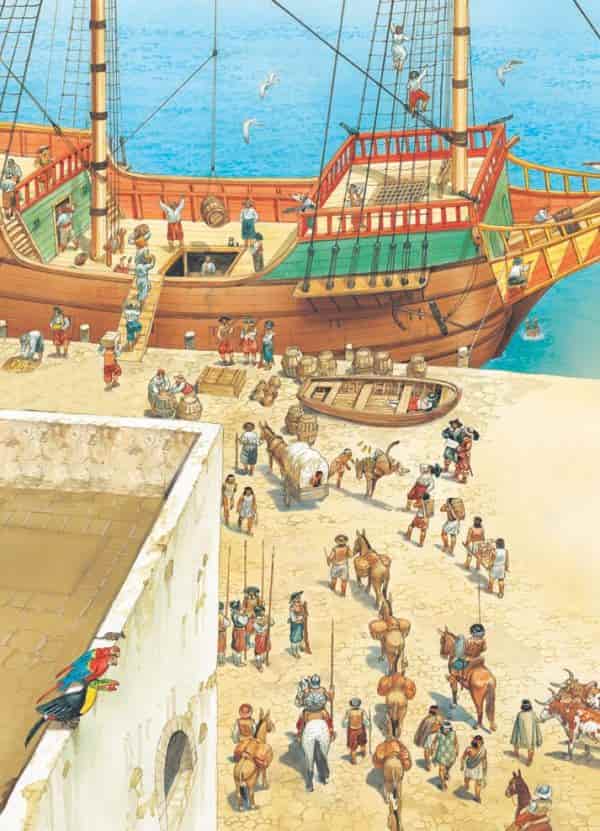
In 16th-century Spanish circles, the basic rule prescribed by shipbuilders and the administration entailed how each ship should carry one person per tonelada of its weight.
However, in practice, the ratio was far more skewed in favor of the cargo (rather than the crew) with figures of one person (gente de mar or mariner) per 5.5 toneladas, since the 1550s, and one person per 6.25 toneladas since the 1630s. Simply put, most of the ships, including the galleon varieties, were undermanned during their cargo-carrying voyages across the Atlantic.
But such ratios were only devised for the mariners of the vessel. Added to the crew number were the other men on board, including the soldiers (who were often carried in ratios of one soldier per four toneladas in the 1630s), officers, and assorted passengers. To that end, records of the Spanish navy from the early 17th century show that each galleon had an average of 90 to 100 crew members, excluding the soldiers.
If we go by the aforementioned ratio-based formula, the very same vessel would have additionally carried around 120-125 soldiers onboard. Furthermore, in times of war, the number of soldiers could actually be increased – thus transforming the galleon into a well-armed transport ship instead of a royal-sanctioned commercial vessel.
The Life Onboard the Galleon
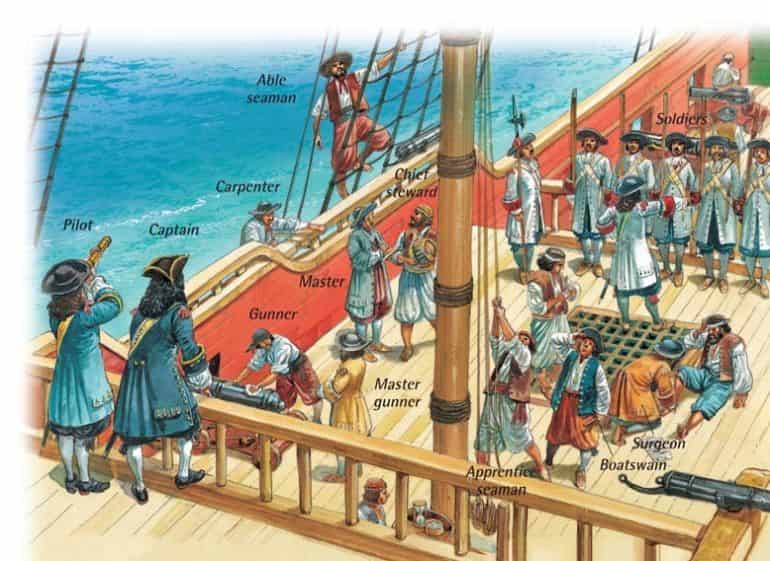
Now while from the mathematical perspective, many of the galleons were possibly undermanned in regards to their weight, the available space for crew members onboard had always been cramped.
To provide an example, a 450-toneladas galleon built in 1628 had a paltry average of just 15 sq ft per person on the ship. And this space was rather reduced for the rank-and-file mariner, especially with the captain and his officers occupying the relatively ‘comfortable’ quarters of the upper deck.
Suffice it to say, such cramped conditions spelled complications when it came to the sanitation of the galleon. For most ships of the era, much of the wastewater, seawater, and human excrement was collected in the bilge area of the vessel – which corresponded to the space below the hold.
Described as ‘steaming like hell and stinking like the devil’ by one Spanish passenger in 1573 AD, the sullied water and the residues even had the tendency to attract rats – one of the major health risks inside ships during the period.
The predicament was even exacerbated by the rats polluting the clean food and water sources and even damaging the sails. Added to this revolting scope was the danger of other vermin, including cockroaches, fleas, and lice. Consequently, the galleons were breeding grounds for various diseases, including yellow fever (and its high mortality rate) exported from the Caribbean.
On the slightly brighter side, especially in Spanish circumstances, their predominantly Mediterranean diet did guard against the onset of scurvy, which was called the ‘Dutch Disease’.
Moreover, proper rationing onboard was a common practice in galleons, with most sailors given their daily share of the ship biscuit made of wheat, menestra – a hearty stew of chickpeas, rice, lentils, and broad beans, and rough red wine. This was complemented by meat (or cheese on occasion), onions, garlic, olives, and vinegar.
The Evolution of the Galleon into a True Warship
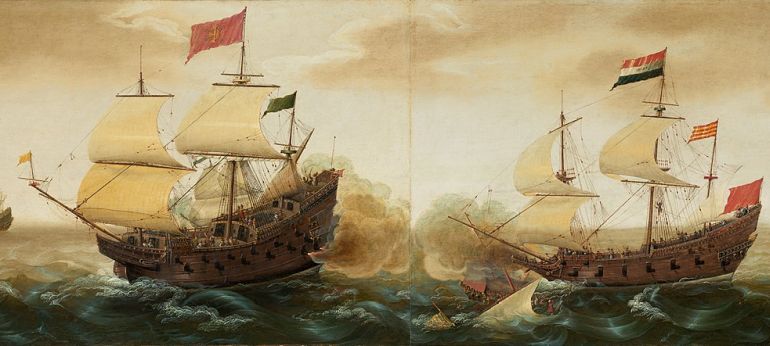
Historian Angus Konstam noted how in the 16th century, the Spanish followed the naval doctrine of ship artillery being used as supporting weapons. In essence, the Spaniards tended to give precedence to boarding actions over artillery duels, possibly because their axiom revolved around their well-trained infantry who could perform better in melee scenarios.
To that end, the early galleons, while refined in their design, tended to serve as armed platforms that could provide supporting fire and resultant smoke – the latter being used for masked maneuvers while boarding enemy ships.
However, in 1588 AD, the Spanish Armada suffered its shock defeat at the hands of the English navy and the unprecedented result pretty much underlined the tactical downside of the Spanish boarding actions. In fact, during the campaign of 1588, the English commanders preferred to engage in artillery duels, thereby not allowing the Spanish galleons and other warships to come in close range.
Thus in the following decades, the galleon’s design and armaments went through numerous changes that rather propelled its status as a dedicated warship rather than an armed carrier.
One of the primary design changes focused on smaller yet more maneuverable galleon types – some of which were also tasked with carrying coins from the Americas. As for the guns on board, many of the older wrought iron specimens were already replaced by bronze ordnance by 1588 AD.
But after the momentous defeat of the Armada, there was an overhaul of the management of the galleon guns. For starters, the experienced sailors, as opposed to the soldiers, were given the responsibility of operating the artillery.
The scope was made more efficient with the correct labeling and storage of the different shots for the various caliber of the guns – which allowed for a streamlined approach during the high-intensity artillery duels. The guns were also supported by larger four-wheeled carriages instead of the feeble two-wheel ones.
Furthermore, boarding actions were still perceived as effective tactics, but the boarding parties were organized and prepared in accordance with their expertise (ranging from melee situations, throwing grenades and incendiaries, to extinguishing fires).
Such alterations were rather reflected in many of the naval battles till the late 1630s – with the Spanish galleons showcasing their mettle (often buoyed by resourceful commanders) in numerous engagements both in the Americas and European waters. The Golden Age of the Spanish galleon culminated at the Battle of the Downs in 1639, where the warships, although heavily battered, held their own against a larger Dutch fleet.
Conclusion – The Decline
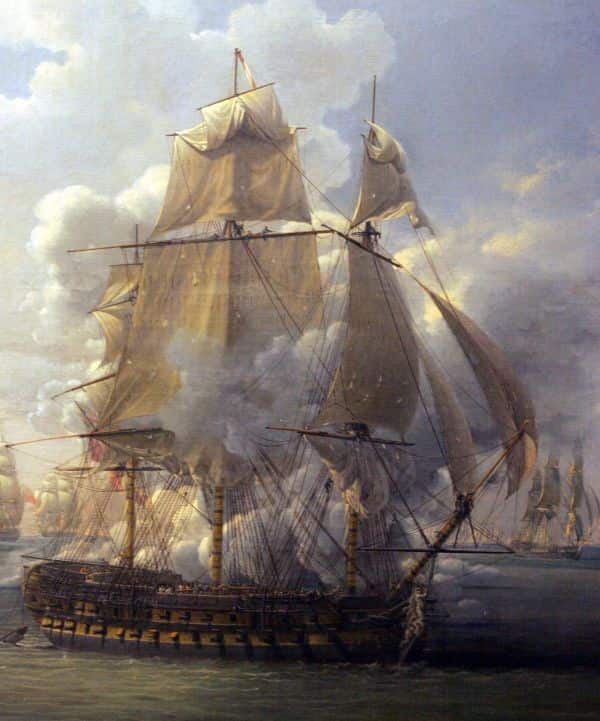
Unfortunately, in spite of the many modifications (both structural and organizational) made on the Spanish galleon, naval warfare in the decades of mid 17th century changed significantly in terms of formations and maneuvers.
To that end, in the following years, one of the widespread tactics adopted by many contemporary European navies related to the ‘line of the battle’ – basically entailing the formation of a line of ships end to end, which allowed them to collectively fire their cannon volleys from the broadsides without any danger of friendly-fire.
The adoption of such tactics translated to ships being used as floating artillery platforms, thereby resulting in the design of heavier vessels with more guns – better known as the ‘ship of the line’. Suffice it to say, the sleeker galleon was ironically anachronistic, with the focus of shipbuilders once again shifting to the bigger warships with broadside artillery platforms. Consequently, the last galleons of the Spanish navy were decommissioned by the late 17th century.
Honorable Mention – The Golden Hind
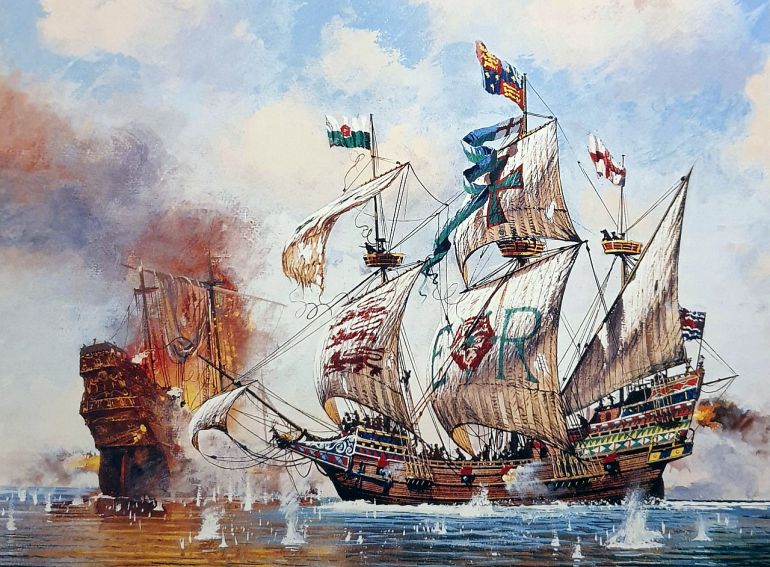
In this article, we have mostly talked about the Spanish Galeón. However, one of the most famous galleons of the 16th century arguably pertains to the Golden Hind – the English galleon captained by none other than Sir Francis Drake.
Used in his circumnavigation around the world (also known as Drake’s Raiding Expedition) between 1577-80, the Golden Hind made voyages to the far corners of the known world, including California (which was named New Albion), Java, and Cape of Good Hope.
Often described as a cross between a carrack and a galleon, the 120-ton Golden Hind famously captured the Spanish galleon Nuestra Señora de la Concepción. This ship carried the largest treasure captured to that date – comprising silver, gold, jewelry, porcelain, cloves, and coins. The overall value of the treasure bafflingly amounted to over 360,000 pesos – equivalent to more than $550 million in current value!
According to historian Arthur Hermen (as referenced in his book To Rule the Waves), over half the proceeds of this privateer feat went to Queen Elizabeth I. And the sum, possibly amounting to £160,000 (in the 16th century), was more than enough to settle the entire government debt of England.
Interestingly enough, given the repute of the Golden Hind in English circles, the ship was said to have been maintained for 70 years for public exhibition at Deptford, London. Unfortunately, the original specimen rotted away and thus was ultimately disassembled. However, in our modern era, the Vasa remains the only original galleon that has been painstakingly conserved. It was originally a 1200-ton Swedish warship that was built on the orders of Gustavus Adolphus, in 1628.
Featured Image Source: Painting by Roland Davies (1stDibs)
Book Reference: Spanish Galleon 1530-1690 (By Angus Konstam)
Online Sources: The Mariner’s Museum / Pirate Glossary / Encyclopedia.com
And in case we have not attributed or misattributed any image, artwork, or photograph, we apologize in advance. Please let us know via the ‘Contact Us’ link, provided both above the top bar and at the bottom bar of the page.
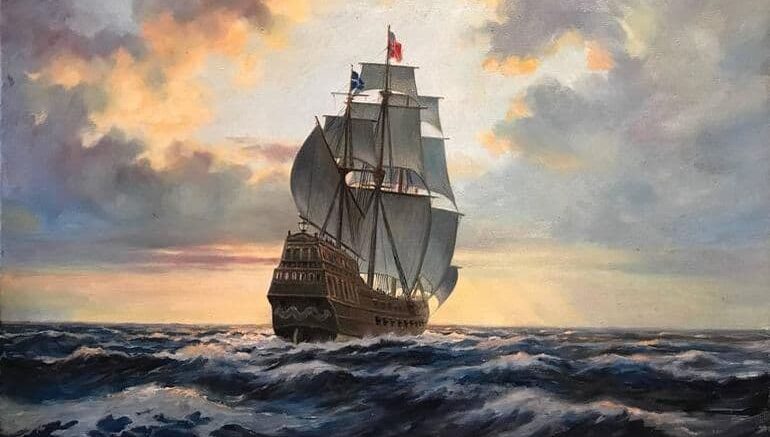


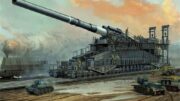

Be the first to comment on "Spanish Galleon: The Definitive Warship of the Atlantic"